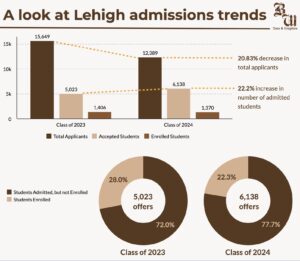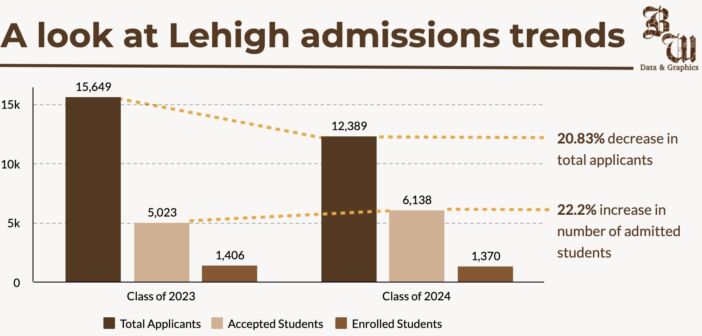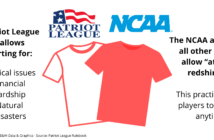Lehigh’s admissions process was complicated by a combination of a 20 percent decrease in applications for the class of 2024 and COVID-19.
On top of the unexpected decrease in applications, the pandemic caused a large number of students to defer their acceptance, given the uncertainty about what the fall semester would look like. Thus, Lehigh admitted more students from the waitlist than in previous years.
At the end of the unusual and elongated admissions cycle, the acceptance rate for the class of 2024 was 49.5 percent.

Graphic by Jenna Simon/B&W Staff
“We had to go really deep into the waitlist, which is not normal procedure,” said Samantha Margolis, ’21, an admissions fellow and tour guide. “The amount of people getting into Lehigh and then choosing not to go this year really skewed the numbers.”
While Lehigh’s acceptance rate hit a historic low of 22 percent for the class of 2022, the acceptance rate for the class of 2023 rose to 32 percent due to an increase in class size as part of the Path to Prominence initiative.
“We knew that the drop in applications would present challenges in terms of maintaining an admit rate that was consistent with the years prior to that,” said Bruce Bunnick, director of Admissions. “We were confident, however, that the pool was qualified.”
While the acceptance rate went up from 32 percent to 49.5 percent, the middle 50 percent of test scores for admitted students was identical to that of the class of 2023.
The middle 50 percent of ACT scores ranged from 31-34, while SAT scores ranged from 1350-1480.
“Our standards did not drop … if the higher percentage of students accepted are at the top of their class, then maybe (a higher acceptance rate) is not a bad thing,” Margolis said.
According to Bunnick, five times the number of students who have historically deferred their admission deferred this year. As a result, the waitlist was used heavily to fill spots.
Fifty-nine students who were accepted as a part of the class of 2024 deferred their admission — seven until spring 2021 and the remainder until fall 2021.
Another reason for extra spaces on the class of 2024’s waitlist was uncertainty of household income, which has been a barrier to students accepting spots at private colleges this year.
“We’ve witnessed a lot of COVID-19 appeals, and we were able to award a lot of additional aid for families,” said Jennifer Mertz, director of Financial Aid.
Mertz said, despite accommodating financial aid appeals, students and families who had a lot of uncertainty about the future of their income during the pandemic may not have chosen Lehigh.
It is unclear, however, why Lehigh saw a 20 percent drop in applications last season.
“That’s something that we are still perplexed by,” Bunnick said. “Why such a precipitous drop in one year?”
One factor that may change application turnout this year is the implementation of a new test-optional policy.
With standardized testing dates largely canceled due to COVID-19, many schools including Lehigh adopted test optional policies allowing students to still apply without SAT and ACT scores.
This year, Bunnick said, 40 percent of the Early Decision I voluntarily submitted SAT or ACT scores.
In efforts to improve application rates, Lehigh is taking extra steps this year to improve its marketing.
“We’ve had these years of really solid growth, followed by an unexpected decline,” Bunnick said. “Now, how do we get back to where we were? Dan Warner, the vice provost of Admissions and Financial Aid, has implemented more communication strategies and has done more to get Lehigh out to new markets than ever before this year.”
To take its marketing beyond traditional measures, Lehigh Admissions turned to TikTok, posting viral content such as the “Mini Lehigh Interview Challenge.”
In addition to building a TikTok presence, Lehigh has been holding virtual panels, interviews and tours.
“We were one of the first institutions that had the ball fully rolling in terms of virtual opportunities,” Margolis said. “June, July and August we had a full (virtual) tour schedule. Lehigh really realized that this is an opportunity to show we can be really good at marketing ourselves again.”
Margolis said the admissions trend this year was a “wake up call” to the university.
“We’ve always had a ‘hidden Ivy (League school)’ persona that has followed us around, and we have rested on that, but we don’t need to be hidden and we don’t need to be an Ivy,” Margolis said. “We are our own institution that offers so much, and we need to be portraying that to prospective students.”






Comment policy
Comments posted to The Brown and White website are reviewed by a moderator before being approved. Incendiary speech or harassing language, including comments targeted at individuals, may be deemed unacceptable and not published. Spam and other soliciting will also be declined.
The Brown and White also reserves the right to not publish entirely anonymous comments.
2 Comments
Wow great article, author has a strong sense of prose
“‘We’ve always had a ‘hidden Ivy (League school)’ persona that has followed us around, and we have rested on that, but we don’t need to be hidden and we don’t need to be an Ivy,” Margolis said'”
Really? Because for me, my mentor, and his father (all Lehigh alumni), that was an integral part of the school’s identity. I think this statement more than any really demonstrates what is wrong with the current leadership.
The core identity, at least to me and the people who I associate at Lehigh, is that it is selective, small, institution which had ample research opportunities and while maintaining the feel of an LAC. I am sorry, but I honestly feel the current leadership no longer represents what the current students and alumni want, but hope to lap on to whatever current fad there is to make Lehigh a “household” name. We are recognized by the people who matter; I am perfectly content with being us “hidden” if that means we keep our fundamental identity.